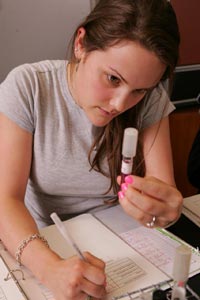FOR IMMEDIATE RELEASE
WNIT Public Television to air Economic Outlook Program on Importance of Educating Women in Science
Media contact:
Gwen O’Brien
Director of Media Relations
Saint Mary's College
(574) 284-4579
March 1, 2011 (Notre Dame, Ind.)—While many people presume that the U.S. will always be a world leader in science and technology, the country is losing its competiveness at an alarming rate. For example, according to data collected by the National Academies of Science, Engineering, and Medicine, the U.S. ranks 27th among developed nations in the proportion of college students receiving undergraduate degrees in science or engineering. Among the Academies’ suggested solutions is to increase the number of U.S. students earning bachelor’s degrees in science, technology, engineering, and mathematics (STEM).[1]
On WNIT Public Television's next Economic Outlook program, host Phil D'Amico, director of business growth at the Chamber of Commerce of St. Joseph County, will lead a panel discussion on how educating women in science-related fields could help the country become more competitive on the world stage. The program will feature a panel of Saint Mary's College science professors, a student, and an alumna. The women’s college has been educating women in science for nearly 150 of its 167-year history. The panel includes:
- Nancy Nekvasil, Chair and Professor, Department of Biology, and Pre-Health Professions Advisor for the College
- Toni Barstis, Professor, Department of Chemistry, and Director of the Dual Degree Engineering Program
- Erin Heck ’08, Dual Degree Engineering Program alumna; Operations Management Leadership Program (OMLP) Associate, GE Aviation
- Tara Hill ’11, Biology Major
Women now earn 60% of the degrees awarded in biological and agricultural sciences, a majority of the chemistry degrees and just under half of the degrees in math. Yet stereotypes and bias are cited as reasons more women don’t enter STEM majors and careers.[2]
In an article in the February 21, 2011 issue of the magazine The Hispanic Outlook in Higher Education, researchers discuss ways to bridge the gender gap in STEM fields. According to the article, studies show that stereotypes about women’s abilities in STEM can reduce a woman’s sense of belonging in the classroom. Also, when students falter in a tough class, this can affect their sense of belonging. Women often leave STEM fields/majors when they feel their peers do not value them. Other research suggests that women’s colleges provide a qualitatively different experience for women compared to coeducational institutions, including higher levels of academic challenge, opportunities for active and collaborative learning, and greater support for women in STEM majors.[3]
“I believe an all-women’s academic environment allows students to take risks with less fear, to try out their ideas, to grow into their own skin,” Nekvasil says. “Without the distractions in the classroom, it allows for free flowing conversation and a sense of more equal footing. Once women find their voice, they can hold their own in any setting. It is a matter of them growing in confidence, of being validated for what they have to offer, and of having opportunity to take leadership positions.”
This half-hour Economic Outlook program will air at 5:30 p.m. on Friday, March 4 and re-air at 12:30 p.m. on Sunday, March 6.
About Saint Mary’s College: Saint Mary’s College, Notre Dame, Ind., is a four-year, Catholic, women’s institution offering five bachelor’s degrees and more than 30 major areas of study. Saint Mary’s College has six nationally accredited academic programs: social work, art, music, teacher education, chemistry and nursing. Saint Mary’s College ranks among the top 100 “Best National Liberal Arts Colleges” in the U.S. News & World Report 2011 College Guide. Founded in 1844, Saint Mary’s is a pioneer in the education of women, and is sponsored by the Sisters of the Holy Cross.
[1] Rising Above The Gathering Storm (2005 Report) and Rising Above the Gathering Storm, Revisited (2010 Report) by the National Academies of Science, Engineering and Medicine
[2] Boston Globe “Good News on Women in Science”, March 28, 2010 http://www.boston.com/bostonglobe/editorial_opinion/oped/articles/2010/03/28/good_news_on_women_in_science/
[3] Source: Kinzie, Thomas, Palmer, Kuh & Umbach, 2007; Pascarella & Terezini, 1991
